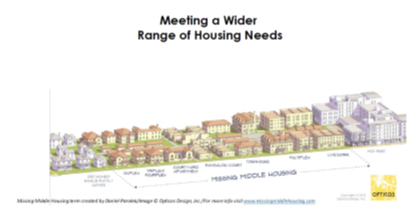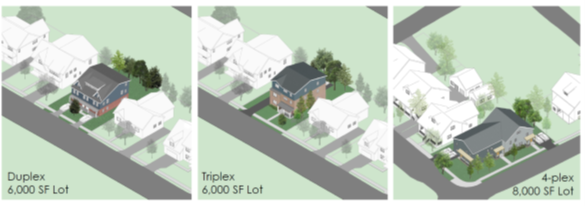Arlington County’s Planning & Housing study “The Missing Middle” has entered its second phase, “Analysis & Draft Framework.” The initiative has garnered attention from homeowners, homebuilders, and community members who are interested in how the plan might impact Arlington.
“The Missing Middle” refers to housing types that exist on the spectrum between detached single-family houses and mid-rise multifamily units. Examples include townhomes, duplexes, multiplexes, and low-rise units. These housing types are in short supply across the County and could become an essential option for people who face displacement, or plan to grow their family in Arlington.
Currently, high property values and zoning regulations drive developers and homebuilders to maximize returns by constructing large luxury homes. Arlington County officials fear that with the steady pace of this new construction, more affordable homes will be extremely difficult to come by. Their solution is to modify the zoning code to allow higher density housing types in residential neighborhoods, including all the existing single family detached areas. By relaxing parking requirements and allowing development of duplexes to multiplexes, with a maximum of eight units, the County hopes to stimulate interest from developers and homebuilders in these neighborhoods.
The County expects development of these different housing types to be incremental over the next thirty years. However, proponents of the plan hope there might be just enough change to immediately provide current Arlingtonians with less expensive options so they can stay in the County.
Proponents of the plan remain unclear about how they plan to incentivize homebuilders to focus on more complicated and potentially less lucrative projects. So far, there hasn’t been any indication about added flexibility to development standards. Nor has there been any discussion about tax benefits for those who undertake these projects or any kind of public private partnership. Either way, any incentives beyond relaxed parking requirements are conjecture.
There is also another option that staff alluded to called “Leveling the playing field.” This option would make building large expensive single-family houses, which is where the current demand is, more difficult, thereby making the other housing types just as appealing. Nevertheless, the County has not hinted how it might incorporate those restrictions into the zoning ordinance. Some commentators have stated that the County’s last effort at restricting larger homes caused homebuilders to focus on this area. It may be months before a draft of recommendations is available and we see what direction staff decides to go.
The land use team at Bean Kinney & Korman will closely watch as the study progresses. As always, please contact us with any questions about the “Missing Middle” or any other land use matters.
This article is for informational purposes only and does not contain or convey legal advice. Consult a lawyer. Any views or opinions expressed herein are those of the author and are not necessarily the views of any client.


